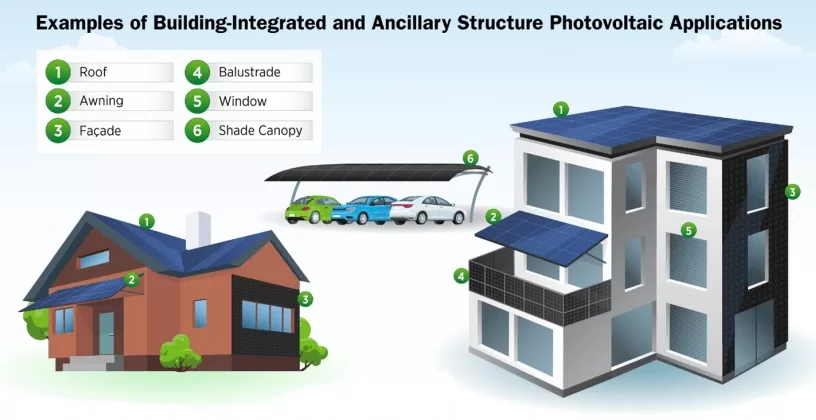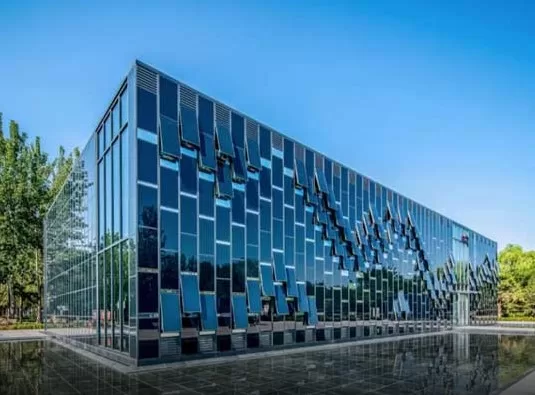Building-Integrated Photovoltaics (BIPV) refers to the integration of solar panels into building structures.You can install BIPV systems as an essential component of a building’s architecture or add them as a retrofit.This article will cover everything you need to know about BIPV, including its benefits, challenges, and applications.
Introduction
Building-Integrated Photovoltaics (BIPV) systems use photovoltaic technology to generate electricity while serving as an integral part of a building’s structure. You can install BIPV on the rooftop, façade, or shading systems of a building, making it suitable for both new construction and retrofit projects. BIPV has gained popularity in recent years due to its potential to reduce carbon emissions and the cost of energy for building owners. In this article, we will explore the benefits and challenges of BIPV, as well as its applications and future prospects.

Benefits of BIPV
Environmental
BIPV systems help to reduce the carbon footprint of buildings by generating renewable energy. The use of solar energy also reduces the reliance on fossil fuels, which contributes to a cleaner environment. BIPV systems can also improve the indoor environment of a building by reducing the heat gain and glare associated with traditional glass windows.
Economic
BIPV systems can help building owners reduce their energy costs by generating electricity and reducing the need for traditional power sources. BIPV systems can also add value to a building by improving its energy efficiency and reducing its carbon footprint.
Aesthetic
BIPV systems can be designed to blend in with the building’s architecture, creating an aesthetically pleasing appearance. BIPV systems can also provide unique design opportunities, such as the use of colored or patterned panels.
Challenges of BIPV
Cost
BIPV systems can be more expensive to install than traditional roofing or façade systems. However, the cost of BIPV systems has been decreasing in recent years as technology improves and demand increases.
Maintenance
BIPV systems require regular maintenance to ensure optimal performance. The maintenance requirements of BIPV systems vary depending on the type of system, but they generally include cleaning, inspection, and repair of damaged panels.
Efficiency
The efficiency of BIPV systems can be affected by factors such as shading, temperature, and orientation. Proper design and installation can help to optimize the efficiency of BIPV systems.
Types of BIPV
Rooftop Systems
Rooftop BIPV systems are the most common type of BIPV. You can install them on flat or pitched roofs, integrating them with the roof’s structure.
Façade Systems
Façade BIPV systems attach to a building’s exterior walls and act as shading devices or alternatives to traditional glass windows.
Shading Systems
Shading BIPV systems provide shade for a building’s windows or outdoor spaces. Installing them on a building’s roof or façade enables designs that move with the sun to optimize energy production.

Applications of BIPV
Residential Buildings
Residential buildings can use BIPV systems to generate electricity and lower energy costs. Installing these systems on the roof or façade of the building allows for designs that seamlessly blend with the building’s architecture.
Commercial Buildings
Commercial buildings can use BIPV systems to generate electricity and lower energy costs. By installing them on the roof, façade, or shading systems of the building, these systems not only enhance the building’s aesthetics but also decrease its carbon footprint.
Industrial Buildings
Industrial buildings can utilize BIPV systems to generate electricity and lower energy costs. By installing these systems on the roof or façade of the building, they can also offer shading for outdoor workspaces.
Transportation Infrastructure
Transportation infrastructure, including train stations, airports, and parking garages, can utilize BIPV systems. By installing these systems on the roof or façade of a structure, they can offer shading for outdoor spaces and generate renewable energy at the same time.
Future of BIPV
The demand for BIPV systems will likely increase in the coming years as the cost of photovoltaic technology continues to decrease, and more building owners aim to reduce their carbon footprint. Technological advances, like the development of transparent solar cells, will also likely contribute to the growing adoption of BIPV systems.
Conclusion
Building-Integrated Photovoltaics (BIPV) systems offer a range of benefits, including environmental, economic, and aesthetic. While there are challenges associated with the installation and maintenance of BIPV systems, they offer an attractive solution for building owners seeking to reduce their energy costs and carbon footprint. BIPV systems can be used in a variety of building types and are expected to become increasingly popular in the coming years.
FAQs
What is BIPV?
BIPV stands for Building-Integrated Photovoltaics, which refers to the integration of solar panels into building structures.
What are the benefits of BIPV?
BIPV offers environmental benefits by reducing carbon emissions, economic benefits by reducing energy costs, and aesthetic benefits by providing unique design opportunities.
What are the challenges of BIPV?
BIPV can be more expensive to install than traditional roofing or façade systems, requires regular maintenance, and can be affected by shading, temperature, and orientation.
What are the types of BIPV?
The three main types of BIPV are rooftop systems, façade systems, and shading systems.
What are the applications of BIPV?
BIPV can be used in residential, commercial, and industrial buildings, as well as transportation infrastructure such as train stations and parking garages.